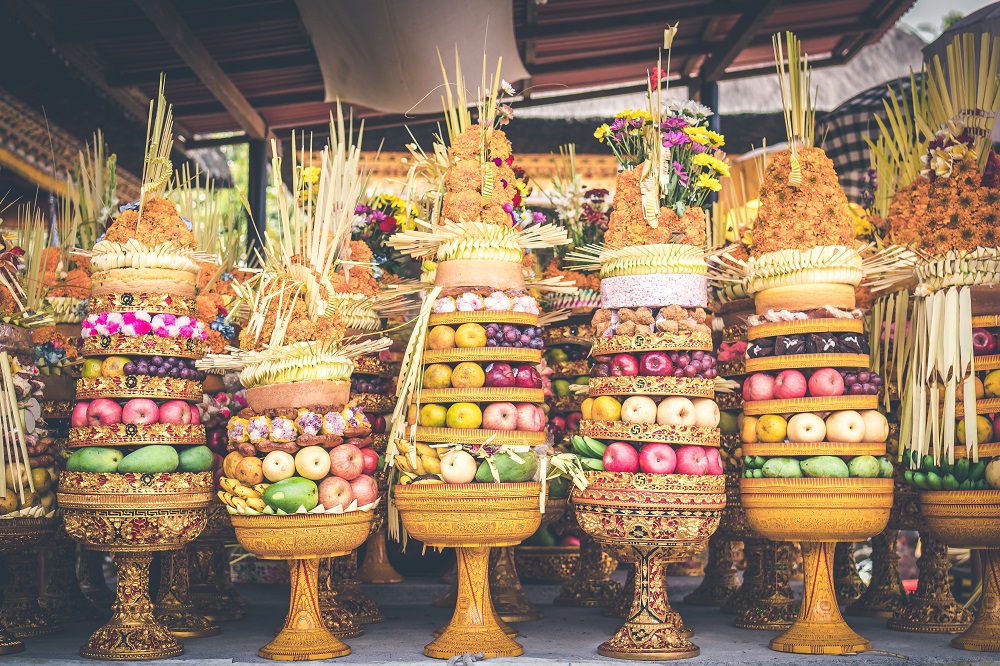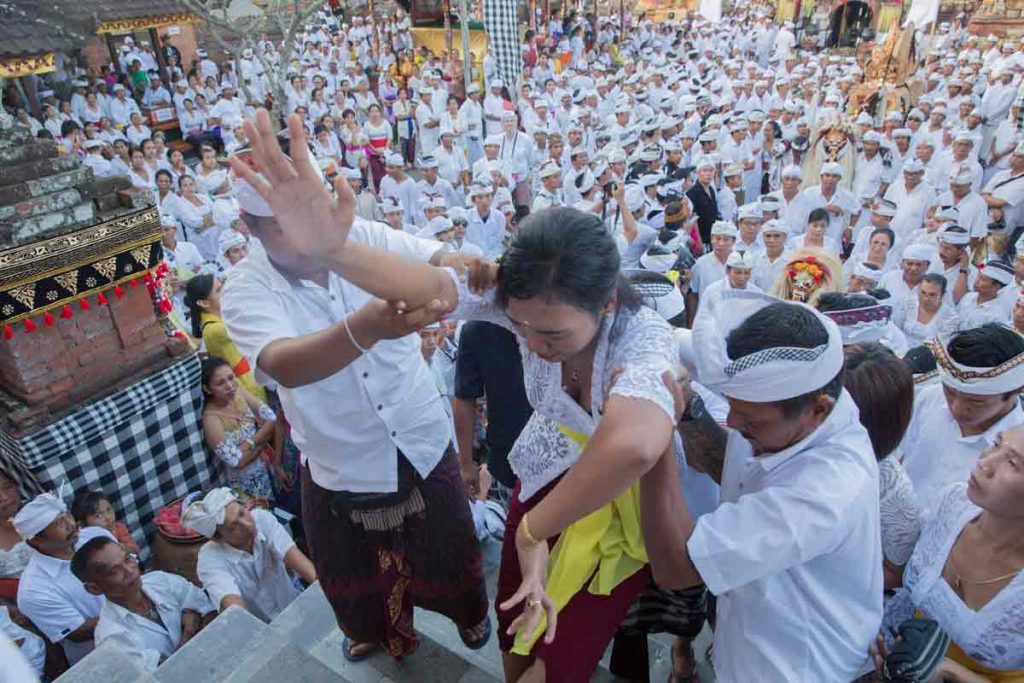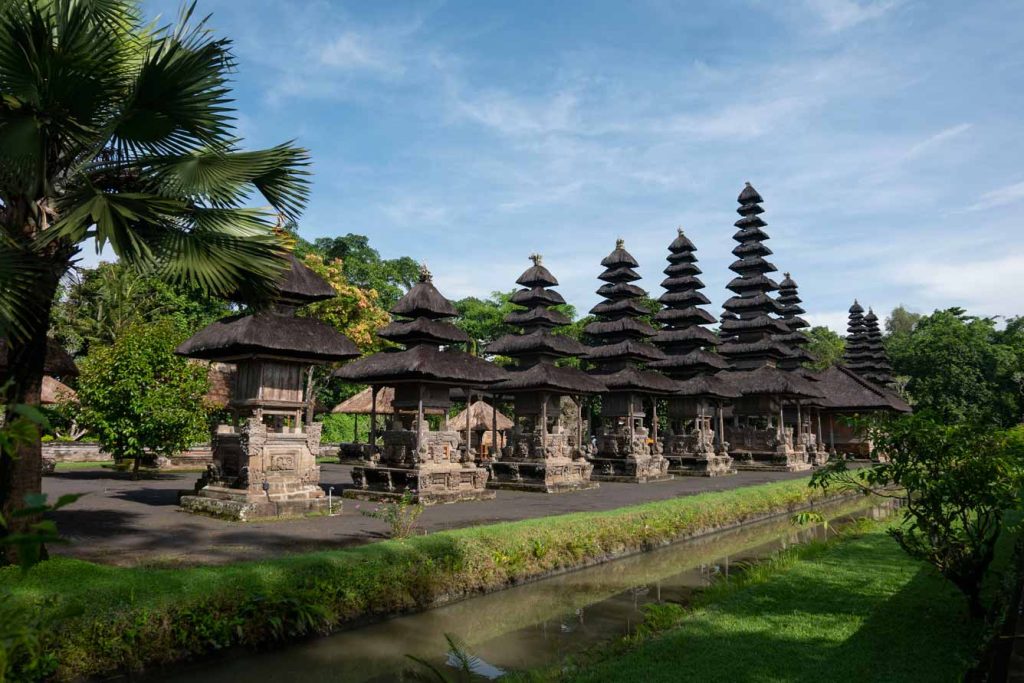The cult of the ancestors is the deepest and most indigenous element of the Balinese religion, and still dominates much of the ritual life of the local people. Let us give a look at this cult, such as it survives in Bali.

The souls of the ancestors reside in a place often called the “Old Country”, (Gumi ane wayah), located above mountainous heights. There, they are told to have become water (dadi yeh) and will reincarnate as drops (titisan) or dew (damuh) of ancestors. However, not all souls reach this “Old Country”; some may be on their way because their rites are not yet completed -they stay in the cemetery as pitra-, while others are stuck on earth and “lost”, becoming threatening “lost souls” (atma kesasar ) – causes of all sorts of illnesses and woes.
The souls of the deified (dewa hyang) ancestors come back periodically, to reside for a few days on the “seats” (pelinggih) attributed to them in temples: this is the temple festival discussed above. But the souls of the dead, including the lost souls, may also come down and “perch” (nginceg) upon a medium (balian tetakson) who, in a state of trance, functions then as a repository (tapakan) in a dialogue with the dead. Each type of dead soul thus consulted has its own set of demands: Tiang suba telung undag mati, sing ada ngerunguang, wireh tiang mati dugas grubuge; gaenang tiang nasi rongan mebe karangan, aturang dilebuhe. Which translates: “I have been dead for three generations, and no one has been paying attention to me, as I died during the times of the plague; prepare me an offering of rongan rice with karangan meat.” If the dead is that of a pure man, he may say instead: Cening, yen cening lakar ngabenang pekak, baang pekak sarwah putih saperadeg or: “Oh, my children, if you want to hold a cremation for me, buy me a white set of clothing.” Such dialogues with the dead usually occur sometime after a parent’s death or ahead of his/her cremation, although mediums may also be consulted to locate the cause of some accident or illness.

Most souls, after undergoing a purgatory purification in the “field of sorrow” or Balinese hell, are eventually expected to find a way back to Bali, either because they have not achieved the conditions for ultimate release (moksa), and thus have to come back and “ask for rice” once more time (nunas nasi), or simply, because they aspire “to see again the beautiful island of Bali.” It is sometimes believed that it is only the shadow that thus incarnates back (mepewayangan) while the original soul remains above the mountain. It is said that such reincarnations can take place as many as 108 times! These beliefs illustrate the peculiar cohabitation in Bali of the “popular” and Siwa-Buddha elements discussed above. The concept of reincarnation is present, but ambiguously, and it does not displace the more ancient ancestors’ cult. To reincarnate may be to find “hell”, in accordance with the samsara theory of Hindu tradition, but it may be, no less often, to find “paradise” by coming back to Bali to live among one’s kin, as believed in the popular tradition. The Hinduization of Bali is thus not “fully” completed yet, after so many centuries!
The orthodox Hindu tradition, though, if any, finds a more receptive ground in the rituals of death proper. Upon death, the body must be treated in such a way so as to rejoin the material “body” of the world, its five composing elements (water, fire, air, earth and void) uniting with their cosmic equivalents: the Panca Maha Buta… At the same time, the soul must be taken on a journey back home, so that it rejoins, in popular lore, the Old Country of the deified souls, or, in the more orthodox version, the Supreme Soul (Paramatma).
The purpose of cremation and other funerary rituals is to implement these concepts. The ritual literally enacts the process of release. According to one’s means, status and other constraints, the after-death rituals vary: there are dozens of varieties of cremations. Contrarily to what is often thought, most families bury their dead provisionally, entrusting the corpse to the goddess Batari Durga and the soul to Batara Rajapati, the lord of death, both of whom reside in the pura dalem or temple of the dead. During their stay in the cemetery, the waiting dead (pitra) must be appeased with regular offerings.
Whatever the case, though, buried or not, the corpse, or an effigy, will sooner or later be cremated, setting off physically, the long process of separation of soul and body. The ashes are then thrown into the sea, enabling the five material elements of the body to blend in their cosmic equivalent (Panca Maha Bhuta).
The cremation of the body and the throwing of the ashes into the sea is only the first step: how to get rid of the body proper. The next ritual steps aim at achieving the release of the soul. When the ashes are thrown away into the sea the soul is entrusted for a time to the god of the sea, Baruna. This cleansing into the sea is often associated in popular lore with the sojourn into hell, which is said to be located on the east of the sea.
Anyway, after a variable length of time – decided by calendar computations – the soul is called back through a small ngulapin ceremony held on the beach; then comes the big post-cremation or purification ceremony of mukur or ngasti – a sort of repeat, minus the body, of the cremation – at the end of which the soul is definitively separated from all earthly bonds. It can then take the path to the mountain, through a succession of ceremonies (nyegara gunung and meajar-ajar), which takes it to the temple of origin of the clan (pedharman), located in the temple complex of Besakih, at the foot of the Mount Agung – the mythical abode of the gods. The soul of the dead, thus, becomes a deified ancestor (dewa hyang/batara).

But this is not finished. The dead soul has to have a place back home prepared, so it can be among its living descendants. Therefore an effigy is prepared, and an ultimate ceremony, the “ngenteg linggih”, enshrines the soul as a newly deified ancestor of the family temple. It will thus have its place among the other ancestors in one of the thatched shrines of the family temple (paibon and rong telu). The dead turned ancestor is now ready to come back to visit during temple festivals and to protect his kin in the meantime. It is ready too to come back to Bali in a new human guise: the reincarnation. In this conception of death, by far the most common, few ordinary people, if any, ever achieve moksa or ultimate release.









